Explore an underwater paradise
Scuba Diving in Costa Rica is the new hype and there is no shortage of travel agencies and diving companies. Let us help you choose from one of the many PADI instruction courses and highest quality dive shops for the rental of diving equipment.
You will discover an amazing collection of marine life in the astonishing waters of Costa Rica. On the Pacific Coast, along with the most wonderful Beaches of Costa Rica, as well as on the magnificent Caribbean side. You can scuba dive all year round, during dry as well as rainy season, although the water temperatures and visibility may vary.
Scuba Diving Diving in Costa Rica – An Unforgettable Experience
Those who know this country well will remember that less than a decade ago, Costa Rica was completely unknown as a scuba diving destination. Today, it has become one of the preferred choices amongst divers and lovers of adventure and exploration. There are sports of all kind like surfing, kayaking, mountain biking, snorkeling and of course scuba diving. We have just begun to find a huge diversity of marine life in Costa Rica.
Scuba Diving Spots
The Gulf of Papagayo for the beginner
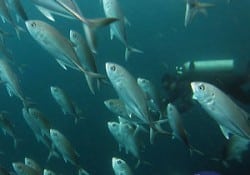 In the northern province of Guanacaste, you will find beaches like Playa Ocotal, Playa Hermosa, and Playas del Coco. These all have good visibility and offer plenty of places to stay. Although mainly known as snorkeling destinations, these beaches are great for those new to scuba diving and want to gain some experience before visiting the more iconic scuba diving destinations. The most famous are the Catalina Islands just off the shore of Playa Ocotal. Water temperatures at the Catalina islands are usually the coldest during the dry season (December to May) and warmer during the rainy seasons.
In the northern province of Guanacaste, you will find beaches like Playa Ocotal, Playa Hermosa, and Playas del Coco. These all have good visibility and offer plenty of places to stay. Although mainly known as snorkeling destinations, these beaches are great for those new to scuba diving and want to gain some experience before visiting the more iconic scuba diving destinations. The most famous are the Catalina Islands just off the shore of Playa Ocotal. Water temperatures at the Catalina islands are usually the coldest during the dry season (December to May) and warmer during the rainy seasons.
Islands
The islands off the Pacific Costa Rican shore are the ideal location to spot the largest variety of marine life. There are regular tours for the intermediate as well as beginner scuba divers to places like Isla Tortuga, Cano Island and the above mentioned Catalinas.
Cano Island

Cano Island is surrounded by coral reefs and rock formations which makes it a hotspot to see marine life. The reefs are stunning and colorful and divers can expect to see manta rays, mobula rays, whale sharks, reef sharks like the white-tipped reef sharks, moorish idols, dolphins, moray eels, sea turtles, and so on. One of the prime diving spots close to the island is El Bajo del Diablo (or “Devil’s Rock”). It lies a little over a mile off the island’s shore. The huge rocks decorating this area create magnificent underwater valleys. You can spot giant manta rays with wingspans of up to 20 feet. A number of shark species can be seen here as well including bull sharks and nurse sharks. If you’re lucky, you can even spot the whale shark. But a sight that will always be available to you are the large schools of tropical fish can be observed around the jutting rocks.
Turtle Island or Isla Tortuga
Isla Tortuga has quite a few activities on the island itself, but the best ones are under water. Prepare to see manta rays, dolphins, octopuses and sharks. Other than stunning marine life, you can also dive to explore a touch of history. Off the shore of Tortuga Island are three shipwrecks you can visit.
 Isla del Coco
Isla del Coco
Isla del Coco, or Cocos Island, possesses a real haven of marine life, known for its schools of sharks, dolphins, and thousands of tropical fish. You can see manta rays, turtles, moray eels and a variety of sharks. Getting to Coco is an adventure in itself with a 36 hours bouncy crossing. Of course, no lodgings are there as it is a protected National Park and you sleep on the boat. Trips can take up to 10 days and cost as much as 6000USD. This is the ideal diving trip for real diving enthusiasts!
Manuel Antonio
Scuba diving tours in Manuel Antonio leave from Quepos. With its 12 islands, there are a great number of diving spots and you’ll see a huge variety of marine life, including snappers, lobsters, turtles, snappers and coral!
Drake Bay
Diving in Drake Bay can offer that extra bit of adventure due to its location in the Osa Peninsula, one of Costa Rica’s most remote locations. You can spot all the usual marine life but the difference in Osa is that you have a shot at spotting the gorgeous humpback whales.
Cahuita
 Also great for snorkeling, Cahuita National Park is known for its spectacular 600-acre coral reef. The reef may have shrunk in recent years but it remains one of Costa Rica’s most popular marine attractions.
Also great for snorkeling, Cahuita National Park is known for its spectacular 600-acre coral reef. The reef may have shrunk in recent years but it remains one of Costa Rica’s most popular marine attractions.
In Cahuita you can see a wide variety of coral including the blue staghorn species, the light yellow brain, and elkhorn. The marine life decorating the coral are hundreds of species of fish and invertebrates such as sea urchins, blue parrotfish, angelfish, stingrays and barracudas. Divers can also explore the wreckage of a former slave ship. Here you can still see cannons and manacles that paint a picture of a darker period in Costa Rica’s history.
Gandola Manzanillo Wildife Refuge
The Gandoca Manzanillo Wildlife Refuge is considered one of the best spots for snorkeling and scuba diving on the Caribbean Coast of Costa Rica. Sea turtles (nesting season is from March to July), dolphins, manatees and crocodiles are just some of the creatures that call Gandoca Manzanillo home.

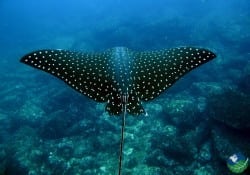 Isla del Coco
Isla del Coco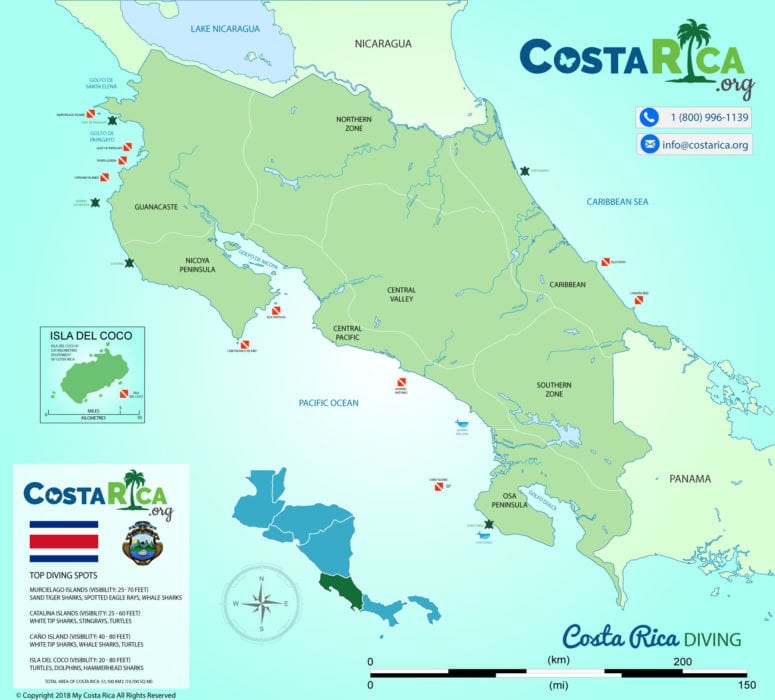
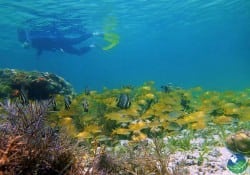
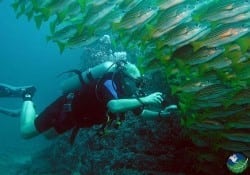






Follow Us